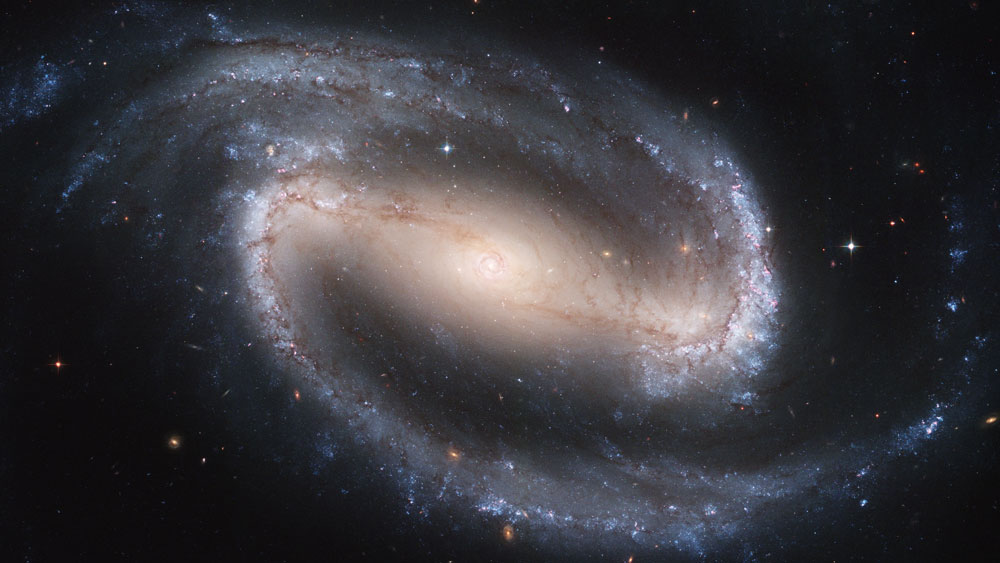Conventional theories have a difficult time accounting for the existence of a distant galaxy whose existence has been revealed by the James Webb Space Telescope.1,2 This galaxy, designated ceers-2122, is a barred spiral galaxy. As the name implies, a barred spiral galaxy is a galaxy with a spiral-like shape and a “bar” of material crossing its center (see figure). Our own Milky Way galaxy is a barred spiral.
The continuous, rainbow-like spectrum of light from a galaxy contains narrow, dark lines called absorption bands that are located at particular, discrete wavelengths in the spectrum. However, these wavelengths are greater than they would be had the light been emitted from a stationary source near Earth. Redshift, denoted by the letter z, is a measure of the fractional change in these wavelengths. A redshift of 1.0 means no stretching, and a redshift of 1.2 means that the wavelengths have been stretched by 20%. High redshift galaxies are farther away than nearby galaxies. The cause of the redshifts is usually assumed to be an expanding universe. Creationists don’t dispute that the redshifts represent distances, but some creationists have suggested that they might be caused by something other than an expansion of space.
The ceers-2122 spiral galaxy has a redshift of about 3.0, which is fairly high. Big Bang astronomers think it takes billions of years for light from very distant, higher-redshift galaxies to reach us. Although this may seem reasonable given the vast distances of these galaxies from us, creationists think this assumption can be challenged.3,4 Because they assume it took billions of years for the light to reach us, Big Bang astronomers think we are seeing these very distant galaxies, not as they are now, but as they were billions of years ago. By conventional assumptions, ceers-2122 was already a mature galaxy just two billion years after the Big Bang.
However, state-of-the-art computer simulations “struggle to produce barred spiral galaxies beyond z > 1.5, especially at lower masses.”2 The difficulty is that distant, high-z galaxies are thought to be more gas-rich and turbulent than nearby galaxies, and these conditions are thought to prevent or delay the formation of barred spirals. A popular science summary stated,
Astronomers previously thought this galactic [bar] structure marks the end of a galaxy’s formative years, so it was expected to be seen only in old galaxies that may have reached full maturity—perhaps those that existed halfway through the evolution of the universe....This is a surprising find, as the galactic bars are seen in roughly two-thirds of all spiral galaxies, but bars are thought to have manifested about 4 billion years into the birth of the universe.1
In short, evolutionary models struggle to account for the existence of a “mature” galaxy so soon after the alleged Big Bang. This is just one more example of the “distant mature galaxy problem” that has long plagued the Big Bang model5,6,7 and has been greatly exacerbated by the data from the James Webb Space Telescope.8,9 In fact, the tension between observations and theory is so great that one physicist suggested nearly doubling the accepted age of the universe from 13.8 to 27 billion years!10
Some say Christians should embrace the Big Bang because it implies the universe had a beginning, which agrees with the Genesis account that the universe had a beginning. But the Big Bang contradicts Scripture in virtually every other way. So why should Christians embrace it, especially since it does such a poor job of explaining the data?11,12
The Lord Jesus Christ, not a supposed Big Bang, deserves the credit for the beauty of spiral galaxies, including our own Milky Way galaxy. For “by the word of the LORD the heavens were made, and all the host of them by the breath of His mouth....Let all the earth fear the LORD; let all the inhabitants of the world stand in awe of Him. For He spoke, and it was done; He commanded, and it stood fast.”13
References
- Kuthunur, S. James Webb Space Telescope reveals most distant Milky Way galaxy doppelganger. Space.com. Posted on space.com November 8, 2023, accessed November 9, 2023.
- Costantin, L. et al. 2023. A Milky Way-like barred spiral galaxy at a redshift of 3. Nature. Posted on nature.com November 8, 2023, accessed November 9, 2023.
- Humphreys, D. R. Toward a More Biblical Cosmology. Gateway Creation Conference. Posted on youtube.com November 22, 2021, accessed November 9, 2023.
- Humphreys, D. R. 2022. A more biblical cosmology. Journal of Creation. 36 (3): 1–9.
- Thomas, B. ‘Old’ Galaxy Found in ‘Young’ Part of the Universe. Creation Science Update. Posted on ICR.org May 24, 2011, accessed November 9, 2023.
- Hebert, J. ‘Early’ Spiral Galaxy Surprise. Creation Science Update. Posted May 1, 2020 at ICR.org, accessed November 9, 2023.
- Hebert, J. Most Distant Rotating Disk Galaxy Challenges Secular Models. Creation Science Update. Posted on ICR.org May 28, 2020, accessed November 9, 2023.
- Hebert, J. 2022. James Webb Telescope vs. the Big Bang. Acts & Facts. 51 (11): 14–17.
- Hebert, J. Webb Telescope Continues to Challenge Big Bang. Creation Science Update. Posted on ICR.org January 26, 2023, accessed November 9, 2023.
- Hebert, J. Big Bang Troubles? No Problem, Just Double the Universe’s Age! Creation Science Update. Posted on ICR.org July 31, 2023, accessed November 9, 2023.
- Hebert, J. Astronomy Magazine: Big Bang in Crisis? Creation Science Update. Posted on ICR.org May 21, 2020, accessed November 9, 2023.
- Hebert, J. New York Times: Big Bang Unraveling? Creation Science Update. Posted on ICR.org September 14, 2023, accessed November 9, 2023.
- Psalm 33:6, 8–9.
* Dr. Hebert is Research Scientist at the Institute for Creation Research and earned his Ph.D. in physics from the University of Texas at Dallas.




















